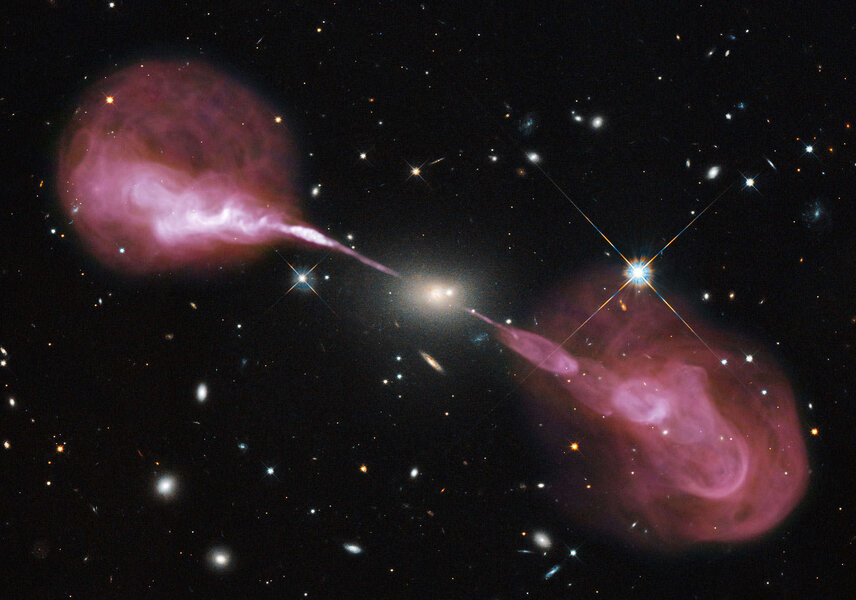Create a free profile to get unlimited access to exclusive videos, sweepstakes, and more!
Like a runaway locomotive, NGC 1265 is leaving a 'smoke' trail behind it

One of the more amazing facts about supermassive black holes — gigantic black holes that can have billions of times the Sun's mass and which sit in the centers of big galaxies — is that they can drive some of the most energetic events in the Universe.
As material like gas clouds and stars fall into them, they get torn apart and form a thin flat disk called an accretion disk. Friction makes it ridiculously hot (the gravity of a black hole is fierce (duh) so the friction inside the disk is enormous), and that material then becomes intensely luminous, able to outshine all the stars in the galaxy combined.
Right in the center, above and below the black hole, the revolving disk twists up magnetic fields, forming two conical vortices very much like tornadoes. The strength of this magnetic field is huge, and material from the disk can flow along it, ripped away from the disk and flung outward into space in twin beams called jets. In some cases this matter is blasted away at very nearly the speed of light, and the magnetic field maintains its structure even for very long distances. That keeps the jets collimated, focused, and that means they can plow through the material inside and even outside the galaxy, continuing their journey for a long, long way.
Eventually they lose momentum and puff up, forming huge lobes of material like the ends of a Q-tip. These structures can be staggeringly huge, over a millions light years end-to-end.
That's if, though, the galaxy is just sitting there. What if it's not?
Many galaxies in the Universe belong to clusters, hundreds or sometimes thousands of galaxies all orbiting their common center of mass, like bees buzzing through a beehive. In between galaxies is a thin gas, called the intercluster medium. What if one of our jet-blowing galaxies is screaming through a cluster with gas like that?
Well, this:
Cooooool.
That is the galaxy NGC 1265, a member of the large Perseus galaxy cluster about 350 million light years from Earth. It's an elliptical galaxy, looking more or less like a football, but it's also an active one, blowing out a pair of jets. As it moves through the cluster it feels a wind caused by its own motion through the thin gas. This blows the jets back, like a dog with floppy ears sticking its head out a car window.
The image is a combination of visible light from the Sloan Digital Sky Survey that shows stars in our Milky Way and the galaxy NGC 1265 itself, and a radio image using the Very Large Array that shows emission from the jets. You really get a sense of its motion!
When I saw this image though, it took about three seconds for me to go, "Wait, what?" That's because that's when I noticed the trail left behind by the jets bends, and by quite a bit. By eye I'd guess 45°. What could do that?
The most likely explanation is that the galaxy's motion changed. It used to be heading down to the lower left in the image, but then something made it swerve hard. Maybe it passed another galaxy, and the two did a little square dance, swingin' their pardners 'round, flinging both in different directions.
But what galaxy did that? It's not clear.
And it gets weirder. Using the VLA in a different configuration*the astronomers got a deeper image showing the tail doesn't just bend, it actually wraps around the entire galaxy.
That part appears to be made of thin filaments a couple of thousand light years wide and hundreds of thousands of light years long. I'd guess this has to do with magnetic fields, which can constrain material like that, but in their paper the authors give several possible explanations, and without further observations they're just guesses. Given that the galaxy itself is still moving through the gas in the cluster, explaining that shape is going to be difficult.
The Perseus cluster is one of the closer clusters to us for its size, and its denizens get studied quite often (like the biggest galaxy in the cluster, NGC 1275, featured in this amazingly cool image of it in X-rays showing its hot gas halo). Maybe more images in different wavelengths of light will solve this mystery.
Until then, most likely we won't know. One thing about astronomy is, it's very satisfying when you get answers, but a lot of the time what you get with new observations are more mysteries. You just have to learn to live with them.
*The radio dishes making up the VLA are on wheels, and can be moved into different configurations to achieve different scientific goals like getting deeper, more sensitive images, but sacrificing resolution to do so.






























